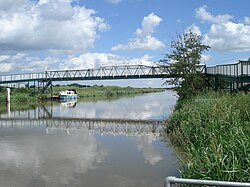Fiskerton, Lincolnshire
| Fiskerton | |
| Lincolnshire | |
|---|---|
 Five Mile Bridge across the Witham | |
| Location | |
| Grid reference: | TF050720 |
| Location: | 53°14’6"N, 0°25’42"W |
| Data | |
| Population: | 1,209 (2011) |
| Post town: | Lincoln |
| Postcode: | LN3 |
| Dialling code: | 01522 |
| Local Government | |
| Council: | West Lindsey |
| Parliamentary constituency: |
West Lindsey |
Fiskerton is a small commuter village in Lindsey, the northern part of Lincolnshire. The population of the civil parish at the 2011 census was 1,209. Fiskerton is about six miles east of the county town, the City of Lincoln, and on the north side of the River Witham.
Churches
The parish church, St Clement, stands at the side of the main road through the village. It dates from the 11th century, and was restored in 1863. The church is a Grade I listed building.[1]
The arcade of the north aisle is Norman; that of the south aisle, Early English Gothic. The Perpendicular Gothic-style tower is square, but encloses an earlier round tower.[2]
It was reported in 1916 that a brass effigy of a priest (c. 1485) in the south aisle was restored to the church by Bishop Trollope in 1863, having been found in a Lincoln dealer's shop.[2]
A Wesleyan Methodist chapel was built in the village in 1839.[3]
Archaeology and history
Fiskerton has received international archaeological attention on a number of occasions over the last two centuries following discoveries of Iron Age artefacts buried in the fenland peat that surrounds the village. In 1826 a fine, decorative shield three feet long was discovered in the River Witham, near Washingborough.[4] Now known as the Witham Shield it has been dated to the second century BC (200–100 BC) and is in the British Museum.[5][6]
Over 150 years later when a dyke was being cleaned, a series of posts were found together with an early to mid-Iron Age sword. Subsequent excavations in 1981 revealed the posts to be a wooden causeway which dendrologists dated to a period between 457 and 300 BC. It appeared to have been repaired and added to every eighteen years or so during that period and the construction and maintenance of a walkway on such a scale at that time would have been a major feat of engineering. Hundreds of artefacts were also found around the causeway, including eleven spears, six swords, woodworking and metalworking tools, as well as part of a human skull which had a crescent-shaped chop mark, probably inflicted by a sword; this injury is unlikely to have killed the man.[7] It is possible that the Witham Shield was originally deposited beside this causeway.[5]
Twenty years later in further excavations more sections of the causeway were dug out, some of them containing posts several metres long, plus a complete spear, a currency bar, a sword, a dagger and some bronze fittings, all of which appeared to have been deliberately damaged before their burial.[8] The most important discovery was two votive Iron Age boats. One of these boats (the Fiskerton log boat) as well as other artefacts can be seen at The Collection (Lincolnshire)|The Collection in Lincoln. The area around the site of the causeway, which is alongside the road to Short Ferry, (a hamlet a mile and a half to the east) opened as a nature reserve managed by the Lincolnshire Wildlife Trust in 2006.
During the Second World War, an airfield was built on agricultural land to the north of the village. RAF Fiskerton opened in January 1943 as part of 5 Group, RAF Bomber Command as 52 Sub-Base Station controlled by RAF Scampton. It closed at the end of the war in September 1945 and the land returned to agricultural use. Very little can be seen of the old airfield now, but a memorial to No. 49 Squadron RAF and 576 Squadron, who were stationed at the airfield during the war, can be found by the side of the road between Fiskerton and Reepham, a village a mile and a half to the north.[9]
Outside links
| ("Wikimedia Commons" has material about Fiskerton, Lincolnshire) |
References
- ↑ National Heritage List 1064020: Church of St Clement (Grade I listing)
- ↑ 2.0 2.1 Cox, J. Charles (1916) Lincolnshire p. 249; Methuen & Co. Ltd
- ↑ Kelly's Directory of Lincolnshire with the port of Hull 1885, p. 394
- ↑ Stead, Ian, 1985, 1996. Celtic Art. British Museum Press. Chapter 5, Weapons and armour, p 72.
- ↑ 5.0 5.1 Pryor, Francis, 2003. Britain BC: Life in Britain and Ireland before the Romans. HarperCollinsPublishers. London. Chapter 12, Glimpses of Vanished Ways (the later Iron Age: 200 BC—AD 43, and After), p 408.
- ↑ Pryor, Francis: 'Britain AD: A Quest for Arthur, England and the Anglo-Saxons' (HarperCollins, 2004) Chapter 8, The Making of the English Landscape, p 218
- ↑ Field, Naomi and Pearson, Mike Parker, 2003. Fiskerton: An Iron Age Timber Causeway with Iron Age and Roman Votive Offerings, Oxbow Books, Oxford
- ↑ Kennedy, Anra. "Treasures of the Celtic Causeway – The Fiskerton Log Boat", Culture24, 26 March 2002. Accessed 24 November 2009
- ↑ National Monuments Record: No. 1395431 – Fiskerton Airfield

